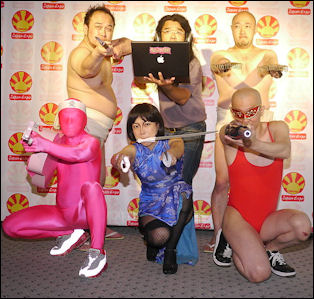Manga in France

Japan Expo in 2011Manga is very big in France, The annual Festival Internationale de la Bande Dessince is regarded as the best manga festival in the world. There are manga cafes and bookshops that specialize in manga on Paris, The ninth Japan Expo in Paris in 2008 was held in a space twice the size of the Tokyo Dome. More than 130,000 people showed up, many of the fans between the ages of 15 and 22 show in cosplay outfits, even a “Gosuu-rori” Lolita outfits.
About 40 percent of the comic books printed in France in 2009 were Japanese manga. More than 1,200 manga titles and works by 450 manga artists have been translated to French. More than 13 million manga books have been sold.One Piece, Natuto and Dragonball have particularly large followings. Narutohas sold over 7.7 million copies in 37 volumes; Dragonball, 19 million copies. Books stores say that around 35 percent of their comic book sales are manga. In 2006, there was a story of a 16-year-old girl who were taken into protective custody in Poland after emrbaking on an overland journey from France to the Land of Naruto. Horror manga is popular in France. Hideeshi Hino, creator of the Hono Horror series is particularly popular. He was been called “the grandfather of contemporary horror manga.”
Shinya Machida wrote in the Yomiuri Shimbun: “The recent manga boom in France is reminiscent of Japonism--the period when ukiyo-e from the Edo period (1603-1867) greatly influenced French art. At Salon du livre de Paris, France's largest book fair... I saw children wearing masks of characters from the popular ninja manga Naruto written by Masashi Kishimoto and published by Shueisha Inc. The manga's local distributor had set up a booth and was handing out the masks to visitors for free. According to Shueisha, France is the company's largest market outside Japan. Dragon Ball grew in popularity from around 1995, and Naruto was introduced in 2002. From December 2010 to November 2011, Naruto sold 1.22 million copies and One Piece has sold 1.42 million. [Source: Shinya Machida, Yomiuri Shimbun, May 4, 2012]
The Manga Cafe stands near the prestigious Paris-Sorbonne University. Opened in 2006, it houses about 12,000 manga in a space measuring just 100 square meters. Visitors can read manga at the cafe for about 3 euros-4 euros (300-400 yen) an hour. "The characters in Naruto are appealing, and the manga is filled with fight scenes," said a student at the cafe. "In Death Note, I learned about life and death.” [Ibid]
"Manga is artistic because the story, characters and atmosphere are all captured in one panel," said Boris Tissot, organizer of Planete Manga! (Planet Manga), a manga event for young people held at the Centre Pompidou. Another Paris street is crowded with stores specializing in Japanese manga and figurines of characters such as Dragon Ball's Kame Sennin (known in English as Master Roshi) and PreCure. A costume shop there displays a signboard reading "cosplay.” [Ibid]
According to Jean-Marie Bouissou of the Paris Institute of Political Studies, France is the largest importer of Japanese manga. “These days, young people don't believe French culture is special. They don't care about the origins of whatever culture they enjoy. They don't have a particular enthusiasm for being and celebrating things French," the 60-year-old professor explained. [Source: Tetsuya Tsuruhara, Yomiuri Shimbun, October 13, 2010]
Books by French novelists whose writing is heavily focused on Japan are also drawing attention. One of the these is Sympathie Pour le Fantome (“Sympathy for the Phantom”) by Michael Ferrier, 43, who teaches at Chuo University in Japan. Ferrier first arrived in Japan in 1992 and has lived in the country almost the entire time since then. He has published three novels, all of which are set in Japan. [Ibid]
Explaining the reasoning behind setting his books in Japan, Ferrier told the Yomiuri Shimbun: "Due to globalization, societies around the world have undergone rapid change. People from different backgrounds are increasingly mixing together. People are asking: 'What does it mean to be French?' Of course there have been misunderstandings, but Japan has a long history of successfully dealing with different cultures. Through Japan, it is possible for me to think about identity." [Ibid]
Ferrier also explained about French people's interest in Japan, now especially represented by a strong fascination with manga. "It is not a fad. It is a deep, driven interest. Something is shifting in French society," he said. The average age of French people reading Japanese manga is said to be 22 to 23. One survey found that 15 percent of these people would like to work in Japan in the future. [Ibid]
Despite all this In France manga sometimes gets a bad rap. Art historian and manga expert Brigette Koyama-Richard told the Daily Yomiuri, “In France, there are as many people who hate manga as like it, They automatically link manga with violence and sex, without reading it.”
No comments:
Post a Comment